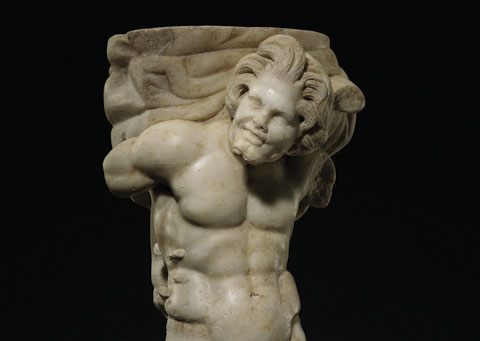Ancient porphyry sculpture has been virtually nonexistent on the open market. It is extremely firm and very difficult to sculpt, yet this piece is exceptionally refined.
Christie’s is preparing a historic auction featuring some exquisitely rare antiquities. The most predominant in the collection is an ancient Roman porphyry statue of the goddess Tyche. “Tyche” is Greek for “luck,” and bidders are going to need a healthy dose of it if they plan to walk away with this extraordinary statue. The goddess Tyche presided over the prosperity of a city, bringing hope and good fortune to the citizens. Today, this statue promises its owner exactly that. The piece is expected to bring in between $4 million and $6 million.
The most distinguishing feature of the statue is the porphyry material, an exceptionally rare stone found in only one quarry on the entire planet. Greek for “purple,” imperial porphyry is found atop a 5,250-foot mountain in the eastern deserts of Egypt. The site, dubbed Mons Porphyrites by the Romans and Gebel Kokham by the Arabs, was last quarried circa 330 A.D., after which it was abandoned due to the extreme difficulty of excavation. Even now, the site is vacant and can only be accessed by Jeeps or similar vehicles with 4-wheel drive and the assistance of local guides. Due to its extreme rarity and rich color, porphyry was regarded as the ultimate luxury material by the Greeks and Romans. The Emperor Nero was buried in a porphyry sarcophagus and imperial children were born within a porphyry chamber.
Ancient porphyry sculpture has been virtually nonexistent on the open market. It is extremely firm and very difficult to sculpt, yet this piece is exceptionally refined. The flowing robes envelope the figure’s curved form and lend this piece its mark as an absolutely exquisite work of art. G. Max Bernheimer, international head of Christie’s Antiquities Department, says, “This is the most spectacular and beautiful sculpture that I have ever had the pleasure to work with. The fact that it is still in impeccable condition makes it all the more exceptional.”
The Tyche statue measures 31.5 feet in height. The material ensures that it was most certainly an imperial commission, likely a gift to one of the great cities of the time, or a local leader. The hands, head, and feet of this statue are missing, and were probably made of white marble. The current owner is Dr. Elie Borowski, who acquired the statue in 1967. From 1980 to 1986, it was on loan to the Liebieghaus Museum of Ancient Sculpture in Frankfurt, Germany, and was later exhibited at the Royal Ontario Museum in Toronto, Canada, from 1986 to 1991. The statue is available for viewing May 31 to June 3. The auction takes place on June 4.





















